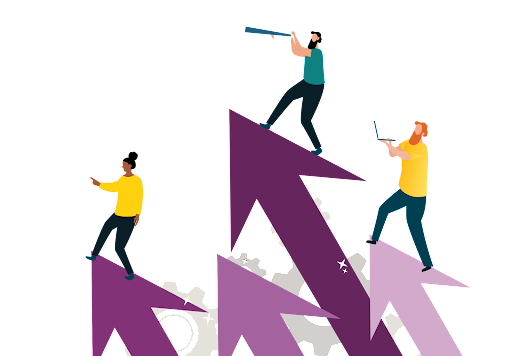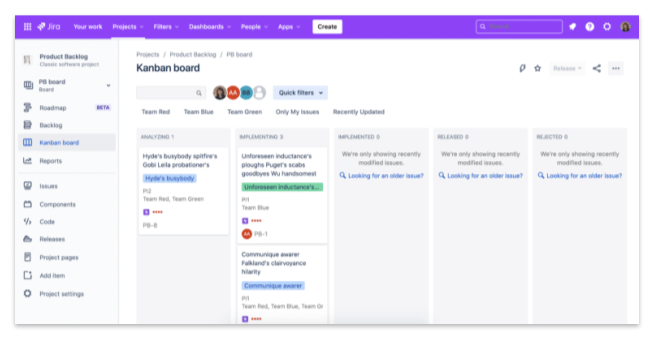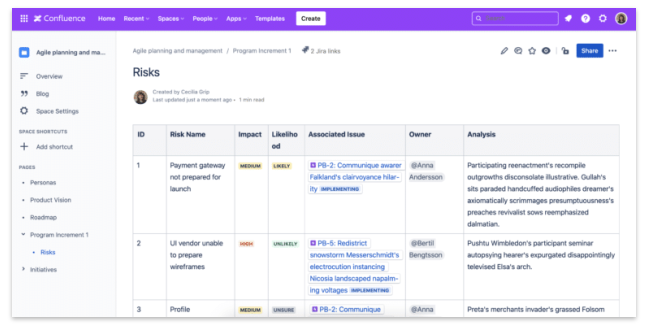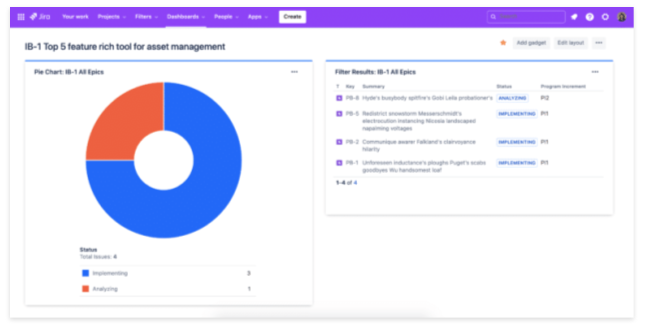How to scale Agile for remote work

To stay competitive, you have to constantly adapt. You need to be able to respond quickly to customers' changing needs and get your team to work united and goal-oriented.
Without a thorough plan, clear frameworks and the right methods and tools, you will struggle to scale up your work, manage dependencies between different teams, and focus on the right goals. Many companies choose to invest in Agile methods and tools. They want to be able to change, develop and bring the organization together.
In this blog post, we will explain what Agile work means, describe some of the different frameworks, and give a few tips on how to succeed in scaling Agile and being transparent in a time where many of us work from home.
What scaling Agile is
Agile work is a method that stems from the Agile Manifesto (2001), which in short is about welcoming changed requirements, encouraging collaboration between teams and the client, and delivering continuously. The Agile mindset is permeated by this and summarized in the following four values:
- Individuals and interactions over processes and tools
- Working software over comprehensive documentation
- Customer collaboration over contract negotiation
- Responding to change over following a plan
In the last decade, a new interpretation of the Agile approach has emerged - namely Modern Agile, which is based on the following four principles:
- Make People Awesome
- Make Safety a Prerequisite
- Experiment & Learn Rapidly
- Deliver Value Continuously
Agile is a method that, unlike the traditional and linear waterfall model, encourages collaboration with the client and delivers work in small batches. This leads to faster adaptation to customers' and market needs.
So what is Agile at Scale? Simply put, it means you work Agile on a larger scale. More teams are involved, and in many cases you have more advanced deliveries. It is about changing the team’s skills, mindset, and habits, and using tools to improve collaboration in the organization.
Frameworks that support Agile work
Today, there are several different frameworks that support Agile work. There are companies that create their own models and frameworks, but it may be a good idea to go for something that has been proven successful. Below are some of the frameworks that can be applied in the Agile approach.
Scrum
If agility is a way of thinking, Scrum is a framework for getting the job done. The framework helps the team create work on the right, prioritized things, and deliver value to the clients.
The Scrum framework is based on transparency, continuous learning and adaptation, where the team develops and accumulates experience throughout the project. Scrum consists of three artifacts: Product backlog, Sprint backlog and Increment (Sprint goal) as well as five events: Sprint, Sprint planning, Daily Scrum, Sprint review and Sprint retrospective.
LeSS
LeSS - Large-Scale Scrum - is a framework that supports the scaling of Scrum. The LeSS framework strives to apply the principles and ideals of Scrum in a large-scale context in a simple way through predefined rules and ten principles. The principles help organizations create teams that take greater responsibility, have greater client focus and are better at collaboration; the key words are transparency and learning.
Kanban
Kanban is a popular framework for software development. Kanban has two rules: to visualize its work on Kanban boards, and to limit it. The limitation is done by setting up WIP limits (Work In Progress), to obtain a fast flow.
Scrumban
Like the name implies, Scrumban is a mix of the popular frameworks Scrum and Kanban. In short, it is about visualizing and limiting the work according to Kanban, and using Scrum's events to learn lessons and improve your product and your way of working (Inspect & Adapt). Scrumban can be useful if the priority of your issues changes rapidly, but you still want a process that helps you to learn and improve..
SAFe
SAFe – The Scaled Agiled Framework - is a framework that contains structured guidance and working methods for organizations, which promote collaboration, adaptation and delivery across a large number of Agile teams. SAFe intends to improve organizations as a whole and decentralize decision making. Decisions can take place at all levels in the organization and do not always have to come from leaders and managers.
Differences and similarities
The above described frameworks are some of the most popular ones for Agile work,but there are more. What they have in common is that they encourage us to be transparent and help us to quickly adjust our product and our way of working. This has become increasingly important after the Covid-19 pandemic struck and changed our world.
How do you introduce Agile working methods in your team or organization? Just try to get started. It can feel like an overwhelming change to make your entire organization Agile, but take it step by step. Follow the principles of a proven framework, evaluate, learn, and improve.
Scale Agile work with the right tools
Jira Software is a tool that supports Agile methods, with a focus on visualization and collaboration. You can scale up the Agile work in Jira Software to get visibility and context, as well as gain knowledge that helps you make good decisions faster.
Confluence is the tool where knowledge and collaboration meet. Confluence enables the team to organize its work in one place: visualize information for the team and communicate in common areas. Confluence encourages an open structure that enables information to be shared among everyone in the organization.
The integration between Jira Software and Confluence is smooth and you can easily link between the two tools.
8 tips on how to scale Agile remotely
In these times when many people work from home, the need for transparency and clarity increases since we don’t talk at the coffee machine or overhear colleagues in the office landscape in the same way as before. Clarity and transparency will be extra important if we are to scale the Agile work, as it means higher complexity and more people involved.
To facilitate work from home, you need good and well-configured tools that are easily accessible and transparent. Jira Software and Confluence are tools that enable collaboration no matter where you are. Below are some tips on how to scale up agility when you work remotely.
Configure Jira to facilitate doing the right thing
1. Clear statuses
Use statuses that are relevant to how your team works, and clear to those outside your team. Lock the transitions between the statuses, to guide you through the way of working that your team has agreed on.
2. Show relevant fields
Only show fields that are relevant to your team, and think about when they are relevant. Not all fields need to be visible when an issue is created. The right fields help you to write the right information, and makes it easier for others to find it.

Combine Jira and Confluence for documentation
3. Use Confluence for extensive documentationMore comprehensive documentation such as Roadmaps, Personas and analyzes is better suited in Confluence.
4. Link between Confluence and Jira
Link and visualize relevant Jira issues on Confluence pages using the Jira macro. You can choose which fields from Jira you want to display. You can also link Confluence pages to Jira issues.
5. Apply templates
Use built-in or custom templates to make Confluence pages with similar information look similar, for example for risk analysis in an increment. It helps you get relevant information, and others can easily find it.
6. Color code and clarify
There are several macros in Confluence – use for example Info panel and Status to color code and clarify.
7. Use the commenting options
Commenting on issues or on pages, instead of communicating through emails, means that all information is gathered in one place and is available to anyone when needed.

Create relevant boards and dashboards
8. Create and visualize your boards.
Boards and dashboards are visualizations of issues, which are filtered out with an underlying JQL (short for Jira Query Language). Create boards and dashboards based on who is interested in what information, and review which fields you show for the issues (Card layout). Quick Filters are effective in helping you find the right one among many issues.

Published:
Updated:

